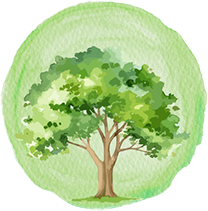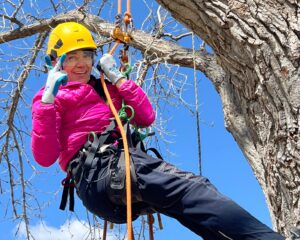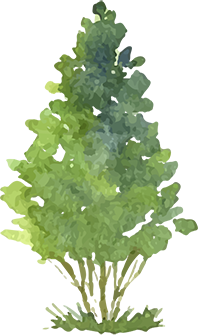Caring for Maturing Trees

Urban foresters use the concept of PEGSMOR to understand the needs of a tree over its lifespan. PEGSMOR stands for Planting, Establishment, Growth, Structure, Maturity, Over-maturity, Replacement. The Planting and Establishment stages were covered above, so we begin here with the Growth stage*:
Growth: Five to ten years in duration. Years of life: 14
Tree is growing but has not reached the desired height of the primary branches.
- Prune every three years: remove deadwood, eliminate weak crotches, eliminate interfering branches.
- Water during dry periods. Winter water.
- Replenish mulch / keep grass away.
Structure: Five to ten years in duration. Years of life: 24
Tree is tall enough to select the primary and secondary branches that will be the main structure throughout the tree’s life.
- Prune every five years for most trees: remove deadwood, select primary and secondary branches, eliminate weak crotches, eliminate interfering branches.
- Winter water.
- Replenish mulch.
Maturity: Twenty to sixty years, depending on species. Years of life: 44-84
Tree develops its full crown and width. Growth dramatically slows during the upper end of this stage, and will remain in this stage until it declines.
- Prune every seven or ten years depending on species, environmental events/stress: remove deadwood, eliminate interfering tertiary and quadrinary branches, eliminate weak tertiary and quadrinary branches.
- Winter water.
Over-maturity: Ten to twenty years duration. Years of life: 54-104
Tree is declining faster than it is growing. Primary and secondary branches begin to rot and die back becoming defective. Root flare may also become defective.
- Prune every three years for most trees: remove deadwood, remove, or stabilize defective branches.
- Monitor structural stability.
Replacement: One to two years duration. Years of life: 56-106
Tree has declined to the point of being totally unsound, or primary branches have been pruned to the point where the tree does not have a viable structure. This stage is needed to finish and subsequently continue the cycle.
- Remove tree, grind stump, replace soil.
- Plant new tree.
Insect and disease problems should be addressed as they arise.
*Adapted from Denver Forestry Division PEGSMOR Fact Sheet
Resources for Tree Care
- Denver’s Office of the City Forester – The City’s arboreal inspectors provide education to residents about tree care and health issues. They can answer almost any question you may have about trees via phone and email and also schedule site visits for some issues. They are also tasked with issuing permits and enforcing regulations governing the planting and removal of trees. So you may contact them directly to request a street tree planting permit if you are planting on your own, outside of Denver Digs Trees. Find your arboreal inspector.
- Licensed Tree Care Companies – In Denver, anyone performing tree care services, including pruning and removal, must be licensed as a “Tree Service Company.” The Office of the City Forester provides a current list of companies licensed to perform tree work in the City & County of Denver.
- Caring for Storm-Damaged Trees – Colorado State Forest Service’s First Aid Tips for Snow-Damaged Trees and Guide to Caring for Storm-Damaged Trees.



